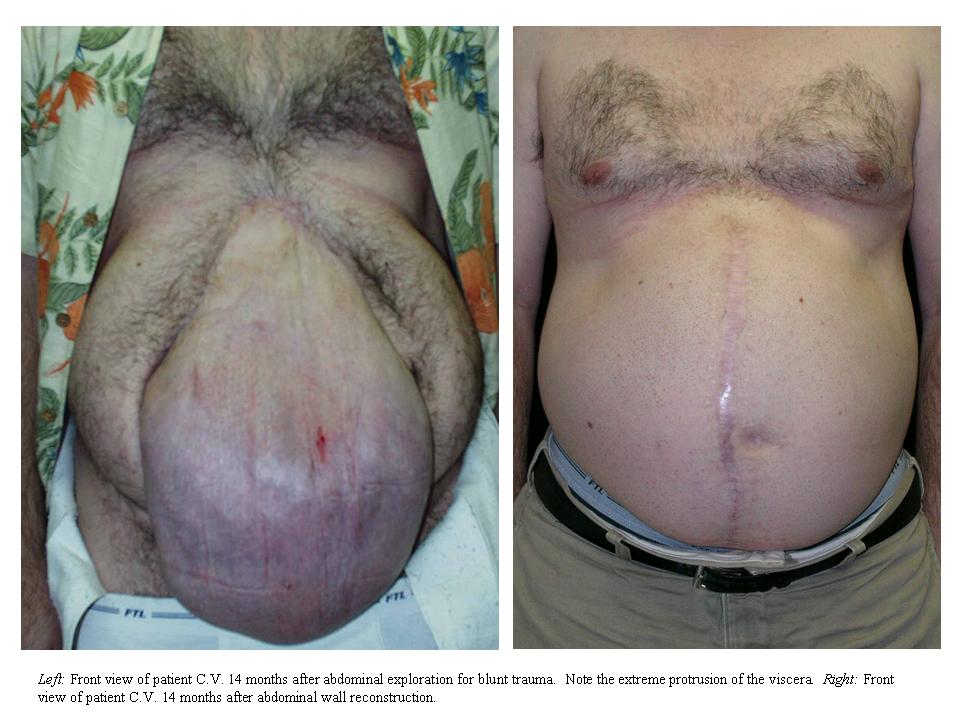Wednesday, October 31, 2007 - 7:20 AM
12693
Damage Control Abdomen: Single-Stage Reconstruction Using a Vicryl Mesh Buttress
PURPOSE: Damage control laparotomy has become an accepted approach for patients with life-threatening abdominal conditions such as trauma and sepsis. While this protocol increases survival rates, it compromises abdominal fascial integrity. There is loss of domain which results in massive hernia. This abdominal wall morbidity can be functionally and aesthetically debilitating for the patient. The purpose of this study is to report our experience and outcomes with these complex abdominal wall reconstructions which represents the largest reported series of repairs of hernias of this magnitude. METHODS: A retrospective review was conducted of 56 consecutive patients with previous damage control laparotomies (13 females, 43 males) who underwent elective abdominal wall reconstruction at a single institution between January 1999 and April 2006. Mean age was 42 years (19 to 80). The abdomen of patients were covered initially by split-thickness skin graft and/or mesh after their original laparotomy. The reconstructive method used in all patients consisted of a double-layer, subfascial Vicryl mesh buttress to aid in establishing abdominal wall integrity, combined with components separation and rectus muscle turnover flaps. Ten patients with massive abdominal defects (1196 to 1836 cm2) required additional Marlex mesh implantation. Activity and functional levels were evaluated by clinical exams and telephone surveys. RESULTS: Major etiologies of abdominal hernias were gun-shot wounds (36.2%), motorvehicle accidents and blunt trauma (23.4%) and sepsis or perforated bowel (23.4%). The mean abdominal wall defect was 865cm2 (150 to 2475), and the average interval time to definitive repair was 16.9 months (3 to 41). The mean length of follow-up was 29 months (1 to 95). Recurrent herniation following definitive repair was 12.5% (7/56). Of these, one was successfully surgically repaired, five were small umbilical hernias that were asymptomatic and did not limit function. One was the result of intentional fascial release for compartment syndrome and has not since undergone reconstruction. Other complications include superficial skin dehiscence, all of which healed secondarily with daily wound care 8.9% (5 patients) and abdominal compartment syndrome 7.1% (4 patients). There were no wound infections, mesh exposures, or seromas. There were two post-operative mortalities, both which occurred in patients with compartment syndrome and were reopened in the intensive care unit. Thirty patients completed telephone surveys (53.4%). Ninety percent of patients who worked full-time prior to injury returned to their jobs, and 92.3% were functioning at pre-trauma activity levels. CONCLUSION: Massive abdominal hernia following damage control laparotomy poses a great challenge to the reconstructive surgeon. This patient population is at significant risk for mortality and morbidity. We present the largest series of repairs of these massive hernias with long-term follow-up and an acceptable hernia recurrence rate. Functional results are excellent with most returning to work and at normal activity levels. We believe the use of a vicryl mesh buttress is an important adjunctive maneuver for definitive, single-stage complex abdominal wall reconstruction.
See more of General Reconstruction
Back to 2007am Complete Scientific Program

